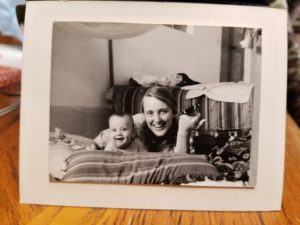
Welcome, friends. If you knew Virginia B. at all, you are surely grateful for having experienced her beautiful spirit & good will. Newcomers, introduced through what’s found here, may feel the same. Even those who knew her well may expect surprises in the words & images left behind, the keenness of her observations, the range of her thoughts & feelings. Most of her work, painting & longer poems especially, remain off-line. The more notebooks are found & pieces typed, the more her larger creative intentions seem to clarify her personal musical movements & artistic intents….
For now, the best intro to her & her work may be found randomly sampling in any & all of the “rooms” listed at the top of pages (in the site’s menu above). A later stage of organizing would presumably offer a recommended pathway & sequence more faithful to her original conceptions, at least in the case of some groupings. Our uploads are more random for now, however, with more faithfully complete groups & sequences possibly added going forward.
Meanwhile, you may freely 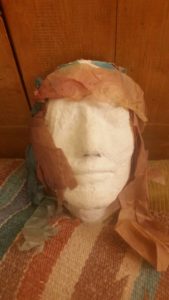 hop about these considerably disorganized pages to experience her gifts of perception, responsiveness, & resonance by means of simple, diverse, individually packed moments charged with breath, tone, spirit, & voice, her feeling & imagination in motion….
hop about these considerably disorganized pages to experience her gifts of perception, responsiveness, & resonance by means of simple, diverse, individually packed moments charged with breath, tone, spirit, & voice, her feeling & imagination in motion….
==========================================================
As host, guide, editor, website flunky, & link in the transmission, Yours Crudely confronts a creative dilemma the horns of which are “stay out of the way–let the work sing for itself” & “help visitors discover the range, depth & impact of her legacy, alert the world, including fellow travelers on the trails of life & art, to her & her work, having been not just a literary librarian able to point in potentially useful directions, but her close companion for more than half a century.
“And belief shall not be until the work is done,” wrote the great poet, philosopher & evolutionary sage Sri Aurobindo. For most of us, perhaps, the work is never done, only passed along when life is. In Virginia’s case, she went on doing her part as she lived–fully engaged in the particulars of trails & companions, exploring the geographies of inner experience feelingly, life & art one, as was her love of nature & culture, children & elders, harvest & gardening, legacy & offering.
She never called herself poet, artist, composer or musician, but practiced each as part of living that much more fully, and shared that sense with her friends, family & students, not in the professional sense of making careers in a field, with body of knowledge & resumé to prove it. While she had the bodies of knowledge & natural talents to have made any of the loved arts (or ecological sciences) her life’s work, she had consciously chosen teaching as profession, a field involving so much she was interested in, arts, sciences, cultures, environment, &, most of all, people engaged in discovering, being, & becoming. In the arts, as in the wild, she remained a devoted amateur, in the original meaning, one who practiced for the love of it, not as a task or job.
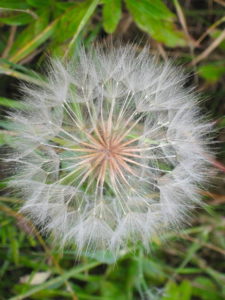 The values found in the arts and sciences, like those provided by society’s various infrastructures (from roads & power grids to institutions, events & community traditions), are functional parts of a common legacy. Each student explored & discovered a personal life’s path, yet also learned working & becoming together, a community with shared values in actual experience, including the dilemmas of actual life, the capacities of society & the sciences, as well as the pleasures of poetry, art, music, dance, wildlife, natural beauty, healthy land, air, water, food, friendship, awareness, wonder, inquiry, feelings, natural & cultural relationships….
The values found in the arts and sciences, like those provided by society’s various infrastructures (from roads & power grids to institutions, events & community traditions), are functional parts of a common legacy. Each student explored & discovered a personal life’s path, yet also learned working & becoming together, a community with shared values in actual experience, including the dilemmas of actual life, the capacities of society & the sciences, as well as the pleasures of poetry, art, music, dance, wildlife, natural beauty, healthy land, air, water, food, friendship, awareness, wonder, inquiry, feelings, natural & cultural relationships….
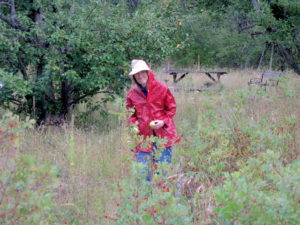
Her professional life, organically grown, was dedicated to the young of all ages, along with the environment. Individuals, community & harmony with nature weren’t primarily ideas to her, nor were the arts something for professionals, practitioners, or profit-seekers alone. Van Gogh’s works thrilled her, as did ones by Matisse, Gauguin, Monet (whose water-garden she visited more than once), the visual playfulness of Klee, Klamdripsky & Chagall & many others, local & far away, known & unknown. Each work, like each artist, was a potential gateway to discovery.
At some early points of her personal history, poetry, dance & music became part of her, along with the love of places & people, wildlife & natural science, body & mind, along with a core sense of justice & right relation. A biographer can trace each to particular early triggers in her intense direct experience, the ways she found the world & became who she did–in Nevada, Hawaii, the Northwest, Radcliffe, Paris, Texas, India…, roots re-set from the early 1970s in New Mexico’s north-central highlands, both in town (Las Vegas, NM) & 20-some miles out (as caretaker & student at Dragon Mountain, our private 200+-acre refuge, guide & teacher).
Her approach to poetry was neither that of a professional writer, someone establishing herself in the field, nor of intentional teacher, someone whose works were intended to guide, inform, or model. For the most part she wrote simply to experience & reflect more fully on life’s mysteries, wonders, sensitivities, & tribulations, the experience of exploring, expressing &/or sharing. Indeed, a significant portion of her poems were communications for particular people, written in response to specific circumstances. In many cases, it would be pointless to ask whether they’re mainly poems at all, remaining communication first & foremost, an affirmation of connection, communion in spirit. Like a tenderly crafted little clay pot or sweater knitted stitch by stitch to keep a loved one warm, the care taken in each poem’s creation embodied her sense of connection with the recipient, friends, colleagues & family members (parents, offspring, Yours Crudely, her life-partner).
I may claim some role in having introduced her to the Basho legacy & encouraged her practice, along with Elizabeth Lamb (of Santa Fe), Gary Vaughn (Albuquerque), our daughter Gita, yet it resonated like 2nd nature, Basho’s core way being so close to her own, “let there be no barrier…,” & once she got the bug, the feel of it, she gave it new life entirely on her own. Though happy to share the gift as part of an evolving linked verse adventure, she mostly celebrated glimpses of beauty & wonder in normal ;ife & solitude, aiming her psychic camera accordingly.
It’s fair to say that her little snapshots knocked the socks off others practicing the Basho way, Elizabeth & Gary included, along with far-off afficianados. A verse of hers that I’d mailed off was named “best of the year” by the Kaji Aso Haiku Society in Boston. Another, published by the American Haiku Society’s Frogpond (when Elizabeth was its editor), received an award from the Museum of Haiku Literature in Tokyo. Though she had no objection to my doing so, she never sought publication or recognition for her work. Indeed, she resisted repeated requests from Orion Afield magazine for an article on her widely admired out-door classroom, far preferring to work with the land & students over writing about working with the land & students.
Age & a gradually progressing Parkinson’s condition changed her active focus, encouraging both professional retirement & her subsequent search for meaning through paint, music & especially poetry, experimenting with each to find some relief from the threats of confusion & physical incoherence, even as the swimmer-diver-&-dancer’s body continued giving way to an unknown, thin-boned old woman prone to falling.
Even before age had dramatically limited outside activities, her writings seemed to be undertaken entirely for her own motives—from the pleasures she found in the dance of words on paper to her efforts at sorting through more difficult feelings…word by word, movement by movement, brush stroke by stroke. After she started listening to classical music overnight, many poems became musical meditations, e.g., reacting to a long loved Sibelius symphony heard on pre-dawn radio, along with attempts to understand what was happening to her mind, brain & body in response to neurological changes….
She had always paid attention to how mind, brain & body interacted–as a hiker, bike-rider, swimmer, diver, dancer, lover…mother, again as yoga teacher, nature teacher, land caretaker, & artist; again as she experienced strange visual phenomena & imperfect muscular coordination; again with the shared tribulations of afflicted friends & death of loved ones, new territories challenging her prior verbal & visual skill-sets.
![]()
![]()
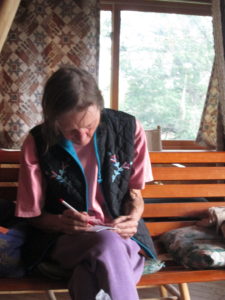 No categories are only what they first seem, so poems written as if for (to &/or about) her own inquiring self could also turn into a direct communication to help a particular struggling friend. Another might cross the imaginary self boundary entirely, speaking to a future self, hers or other later recipient, at once the old & new original….
No categories are only what they first seem, so poems written as if for (to &/or about) her own inquiring self could also turn into a direct communication to help a particular struggling friend. Another might cross the imaginary self boundary entirely, speaking to a future self, hers or other later recipient, at once the old & new original….
Still other poems became games & dances, celebrations & elegies, each defying the usual categories in its own way. The one characteristic shared across all the poetry referred to so far is that the inner poems gave rise to the outer forms, rather than vice versa. Words are grouped & laid out on the page as inner voice & feelings direct, not trying to follow a traditional idea, formula or poetic framework. Given poetic forms were not part of what she explored, with the arguable exception of those in the Basho way.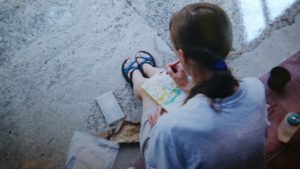
Her hokku & renga contributions emerged from the qualities of attention, more than from a conception of templates, thus fully in sync with the so-called weathergrams discussed elsewhere. Hers mostly wrote themselves, in other words, though in a formal renga session led by a contemporary visiting master, she could also fine tune inner experience to fit its place & functions in the given form.
=====================================================================================
